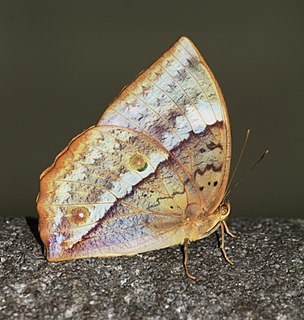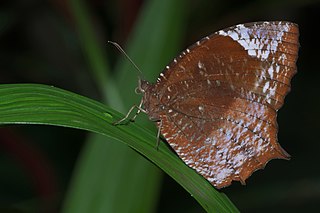
Eurema hecabe, the common grass yellow, is a small pierid butterfly species found in Asia, Africa and Australia. They are found flying close to the ground and are found in open grass and scrub habitats. It is simply known as "the grass yellow" in parts of its range; the general term otherwise refers to the entire genus Eurema.

Leptotes plinius, the zebra blue or plumbago blue, is a species of blue butterfly (Lycaenidae) found in Sri Lanka, India to Australia. The species was first described by Johan Christian Fabricius in 1793.

Athyma selenophora, the staff sergeant, is a species of nymphalid butterfly found in tropical and subtropical Asia.

Colotis amata, the small salmon Arab, is a small butterfly of the family Pieridae, that is, the yellows and whites. It is found in Africa and Asia.

Colotis fausta, the large salmon Arab, is a small butterfly of the family Pieridae, that is, the yellows and whites, which is found in Israel, Syria, Turkey, Iran, Afghanistan, Turkmenistan, India, Arabia, Chad, Somalia and United Arab Emirates.

Azanus ubaldus, the bright babul blue, desert babul blue, or velvet-spotted blue, is a small butterfly found in India, the Middle East and Africa that belongs to the lycaenids or blues family.

Azanus jesous, the African babul blue or topaz-spotted blue, is a small butterfly found in Africa, Egypt, Syria, India, Sri Lanka and Myanmar that belongs to the lycaenids or blues family.

Neopithecops zalmora, the Quaker, is a small butterfly found in South Asia and Southeast Asia that belongs to the lycaenids or blues family.

Euchrysops cnejus, the gram blue, is a small butterfly that belongs to the lycaenids or blues family. It is found from India to Australia. The species was first described by Johan Christian Fabricius in 1798.

Acytolepis puspa, the common hedge blue, is a small butterfly found in Cambodia, India, Myanmar, Thailand, Yunnan, Taiwan, Sri Lanka, Philippines, Borneo and New Guinea that belongs to the lycaenids or blues family. The species was first described by Thomas Horsfield in 1828.

Euthalia lubentina, the gaudy baron, is a species of nymphalid butterfly found in South, Cambodia, and Southeast Asia. It was first described by Pieter Cramer in 1777.

Nacaduba pactolus, the large four-line blue, is a species of lycaenid butterfly found in Indomalayan realm.

Nacaduba hermus, the pale four-line blue, is a species of lycaenid butterfly found in Indomalayan realm. The species was first described by Baron Cajetan von Felder in 1860.

Nacaduba berenice, the rounded six-line blue, is a lycaenid butterfly found in Indomalayan realm. The species was first described by Gottlieb August Wilhelm Herrich-Schäffer in 1869.

Athyma nefte, the colour sergeant, is a species of brush-footed butterfly found in tropical South and Southeast Asia.

Discophora lepida, the southern duffer, is a butterfly found in Sri Lanka and south India that belongs to the duffers group, that is, the Morphinae subfamily of the brush-footed butterflies family.

Ypthima baldus, the common five-ring, is a species of Satyrinae butterfly found in Asia.

Vindula erota, the common cruiser, is a species of nymphalid butterfly found in forested areas of tropical South Asia and Southeast Asia.

The Indian fritillary is a species of butterfly of the nymphalid or brush-footed family. It is usually found from south and southeast Asia to Australia.

Elymnias caudata, the tailed palmfly, is a species of satyrine butterfly found in South India. Some authors consider this as a subspecies of Elymnias hypermnestra.




















